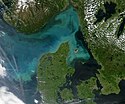Plankton



Plankton er en fællesbetegnelse for de oftest små, encellede organismer – mikroorganismer, der lever frit svævende i havet; marin plankton - eller i luften; luftplankton, aeroplankton eller anemoplankton. Gruppen omfatter meget små organismer, men til gengæld er der helt ufattelige mængder af dem i havet. I en liter havvand findes mere end 10-20 millioner. Gruppen er derfor også det nederste led i havets fødekæde.
At være planktonisk betyder at drive med strømmen, i modsætning til nektonisk, der kan svømme mod strømmen (hvaler, fisk og blæksprutter). Portugisiske orlogsmænd er sensu stricto plankton.
Marin plankton bliver inddelt i to hovedtyper:
- Planteplankton, (fytoplankton) (Græsk phyton, "plante") er alger og autotrofe bakterier. De får energi via fotosyntese og lever øverst i vandmasserne, fordi de behøver lys fra Solen for at overleve.
- Dyreplankton (zooplankton) (Græsk zoo: "dyr") er protozoer, små krebsdyr (f.eks. krill, vandlopper) samt æg, sæd og larver fra større dyr.
Herudover haves:
Planktonnets maskestørrelser
- Megaplankton — 20-200 cm — gopler, tang.
- Makroplankton — 2-20 cm — rejer, havstikkelsbær, pilorme.
- Mesoplankton — 0,2-20 mm — tanglopper, krabbelarver, hummerlarver.
- Mikroplankton — 20-200 μm — diatoméer, amøber, dinoflagellater, radiodyr.
- Nanoplankton — 2,0-20 μm — Kalkflagellater
- Picoplankton — 0,2-2 μm — cyanobakterier (tidligere benævnt blågrønalger), arker[1]
Kilder/referencer
- ^ Introduction to the Archaea Citat: "...However, archaeans are not restricted to extreme environments; new research is showing that archaeans are also quite abundant in the plankton of the open sea..."
- Hjemmesiden: http://www.naturligvis.u-net.dk/ Arkiveret 29. september 2008 hos Wayback Machine
- Castro, P. og Huber, M.:Marine Biology, 1997, WCB Publishers, ISBN 0-697-24360-5
Eksterne henvisninger
- Danmarks Fiskeriundersøgelser: Fisk der æder dyreplankton Arkiveret 28. oktober 2003 hos Wayback Machine Planktivore
| Søsterprojekter med yderligere information: |
Medier brugt på denne side
A large phytoplankton bloom fills Skagarrak, a gulf of the North Sea north of Denmark’s Jutland peninsula, and spills into the North Sea on the west and Kattegat on the east. Phytoplankton are microscopic plants that can form large blooms near the ocean’s surface. In satellite imagery, the blooms are visible as bright blue and green swirls in ocean water. This image was captured by the Moderate Resolution Imaging Spectroradiometer (MODIS) on NASA’s Aqua satellite on June 1, 2004. Skagarrak’s inverted “v” is bordered by Norway, top left; Sweden, top right; and Denmark, lower center. Airplane contrails streak over the North Sea west of Denmark, and a thin plume of smoke is rising from a fire, marked with a red dot, in Jutland.
Phytoplankton bloom in the Bay of Biscay. Satellite: Aqua (EOS PM-1). Pixel size: 250m.
Coccolithophore bloom off Brittany, France. The chalky white exteriors of single-celled marine plants called coccolithophores are coloring the water of the Atlantic Ocean bright blue. Like other types of phytoplankton, coccolithophores are a source of food for marine organisms. Though coccoliths are small, they often form large, concentrated blooms that are visible from space. On June 15, 2004, the Moderate Resolution Imaging Spectroradiometer (MODIS) on NASA’s Aqua satellite captured this image of a bloom off the coast of Brittany, France. The bloom had been developing for a few days before this image was taken.


